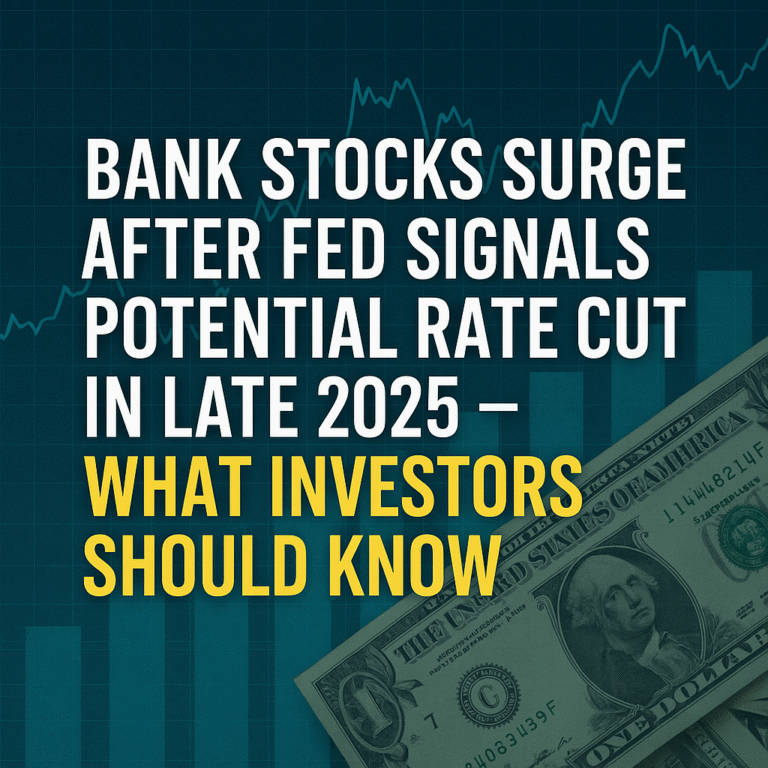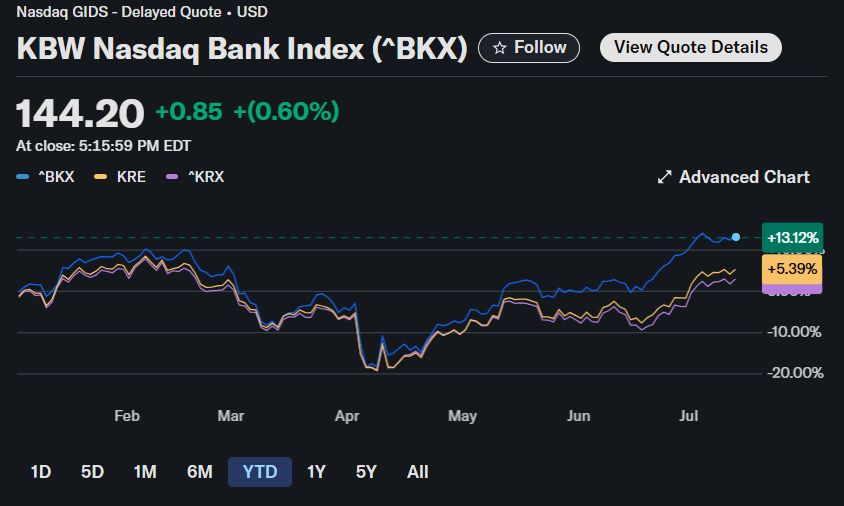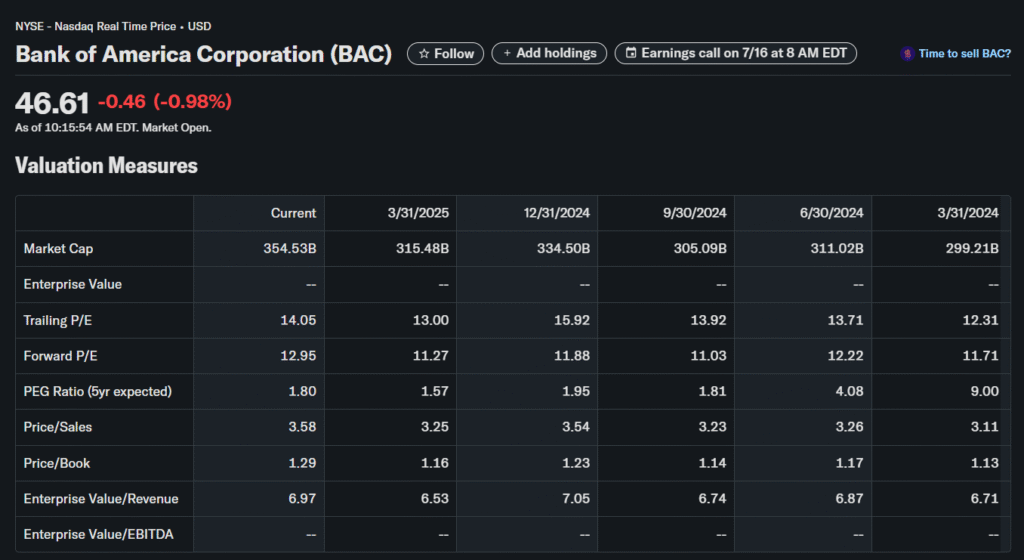
Bank Stocks Surge After Fed Signals Potential Rate Cut in Late 2025 — What Investors Should Know
Bank stocks surged on the heels of the Federal Reserve’s updated dot plot, which now anticipates potential rate cuts in late 2025. The KBW Nasdaq Bank Index jumped over 3% intraday, as investors repriced net interest margins, loan demand, and yield-curve dynamics.
By the end, you’ll have an actionable framework to adjust your stock positioning based on the Fed’s evolving outlook.
Why Bank Stocks Are Leading the Rally
On July 15, 2025, the KBW Nasdaq Bank Index surged 3.5 percent, riding a wave of optimism after the Federal Reserve’s dot plot shifted to anticipate rate cuts in late 2025. Investors cheered the prospect of wider net interest margins and renewed loan demand, pushing financial names like Bank of America (BAC) and JPMorgan Chase (JPM) well ahead of the broader market. This blog post unpacks the drivers behind the rally, highlights key metrics for tracking bank performance, profiles the top movers, and explores portfolio strategies to capitalize on the momentum.

Fed’s Outlook and Market Reaction
The Federal Open Market Committee held its benchmark rate steady at 5.25–5.50 percent but signaled a pivot toward easing by projecting two rate cuts in the fourth quarter of 2025.
This dovish shift from a neutral stance sent bank stocks gapping higher at the open on both the NYSE and Nasdaq as traders repriced future profits around lower funding costs.
Key takeaways:
- Dot plot median now points to 50 basis points of cuts by year-end.
- Chair Jerome Powell underscored a “data-dependent” approach while hinting that inflation may ease more rapidly than previously thought.
- Analysts revised forward earnings estimates higher across the major banks, factoring in narrower net interest spreads on longer-term loans.
Key Metrics to Watch in Bank Stocks
Tracking bank stocks requires a close eye on both top-line growth drivers and bottom-line margins. Here are the most critical indicators:
- Net Interest Margin (NIM)
Lower policy rates typically cause wholesale funding costs to fall faster than the average yield on loans. Over a medium‐term horizon, that differential widening directly lifts bank profitability. - Loan Demand
As borrowing costs recede, mortgages, corporate credit lines, and consumer lending often accelerate. A pickup in originations signals healthy interest-income growth ahead. - Yield Curve Steepness
The spread between 2-year and 10-year Treasury yields is a powerful barometer for bank sector performance. Historic spikes in the 2s-10s curve have coincided with outsized bank stock outperformance. - Deposit Flows and Funding Mix
Shifts from low-cost deposits into money-market funds or higher-yield accounts can pressure margins. Monitoring deposit beta helps forecast funding-cost trends.
Top Bank Stocks Movers

During the late-session rally on July 15, five bank stocks led the charge. The table below compares their intraday gains to the KBW Nasdaq Bank Index ETF (KBWB).
| Ticker | Name | Intraday Gain | Market Cap (USD) | KBWB ETF Gain |
|---|---|---|---|---|
| BAC | Bank of America | +5.1% | 291 billion | +3.5% |
| JPM | JPMorgan Chase | +4.8% | 471 billion | +3.5% |
| C | Citigroup | +6.2% | 132 billion | +3.5% |
| WFC | Wells Fargo | +3.9% | 196 billion | +3.5% |
| COF | Capital One | +7.4% | 69 billion | +3.5% |
Citigroup and Capital One outpaced peers on hopes for stronger consumer lending growth, while Bank of America and JPMorgan delivered rebounds tied to robust trading and wealth-management revenue projections.
Historical Context of Bank Rallies
Bank stocks often lead broader equity rallies during rate-cut cycles. In 2019, for example, regional bank ETFs outperformed the S&P 500 by nearly 12 percent during the Fed’s easing spree. Before that, the 2016 rate-cut cycle saw national banks spike more than 20 percent over six months. These precedents underline how a steeper yield curve and falling funding costs can turbocharge bank earnings multiples.
Risks and Considerations
Despite the optimism, several risks could undermine the rally:
- Timing Uncertainty
The Fed dot plot is a forecast, not a pledge. If inflation remains sticky, rate cuts could be delayed, compressing margins. - Credit Quality Headwinds
Easing rates sometimes mask trouble in commercial-real-estate and consumer loan portfolios. Rising delinquencies could force higher loan-loss provisions. - Regulatory Oversight
New capital requirements, stress-testing outcomes, or changes to deposit insurance premiums could weigh on bank profitability. - Valuation Pressure
After a sharp rally, valuations on a price-to-book and return-on-equity basis may look stretched, increasing the risk of a pullback. - Geopolitical and Market Volatility
Global shock events or renewed market stress can send funding costs spiking overnight, squeezing bank spreads.
How to Position Your Portfolio
If you’re bullish on bank equities but mindful of the risks, here are three strategic approaches:
- Overweight a Broad Bank ETF
Sector funds like KBE, KRE, or KBWB provide diversified exposure to both large-cap and regional banks. - Selective Stock Picks
Identify deep-value opportunities in midsize regionals with strong franchise value—PNC Financial (PNC) and Truist Financial (TFC) often trade below tangible book value. - Risk Management via Trailing Stops
Use a trailing stop set roughly 3 percent below recent swing lows to lock in gains during volatile sessions.
Additional tactics include buying calendar spreads in bank ETFs, or selling covered calls on individual stocks to enhance yield while capping upside.
Broader Outlook for Financials
Beyond traditional lending, banks are expanding in digital banking, wealth management, and fintech partnerships. Higher-rate environments fuel deposit inflows, while AI-driven credit analytics improve underwriting precision. Regulatory capital requirements may tighten, but many large banks boast capital-adequacy ratios well above stress-test minima. Combined with a slowly steepening yield curve, these factors suggest the sector could sustain its leadership through late 2025.
Next Steps
Ready to ride the next wave in bank stocks?
What bank share do you believe has the best risk-reward after the Fed’s dovish pivot? Let us know and we’ll feature top ideas in our next newsletter.